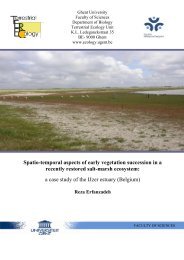PhD Arthur Decae 2010 - Ghent Ecology - Universiteit Gent
PhD Arthur Decae 2010 - Ghent Ecology - Universiteit Gent
PhD Arthur Decae 2010 - Ghent Ecology - Universiteit Gent
Create successful ePaper yourself
Turn your PDF publications into a flip-book with our unique Google optimized e-Paper software.
and femora; all metatarsi and tibiae with dorsal, ventral pro- and retrolateral spines, prolateral<br />
spines on patellae I and II, pro- and retrolateral spines on patella III, no spines on patella IV,<br />
numerous short dorsal and dorso-lateral spines on all femora, spine patterns differ on left and<br />
right legs. Dense pubescence on all femora. Palps (Figs. 23-24): color and pubescence as legs,<br />
dorsal apical spine-group on tibia with two spines left and three right, cymbial spines<br />
Figs. 20-25: Nemesia bristowei sp. n. male. 20 habitus dorsal; 21 habitus ventral; 22 carapace lateral; 23<br />
distal end of right palp, prolateral; 24 distal end of left palp, retrolateral; 25 left leg I clasper, prolateral.<br />
Scale lines = 2mm (20-22), 1mm (23-25).<br />
restricted to distal half of segment. Abdomen light greyish brown with vague dorsal pattern of<br />
darker blotches, fully covered with fine hairs. Spinnerets (as in female, Fig. 31) creamy<br />
yellow. PMS small, spiky, with one apical spigot. PLS basal segment without spigots, as long<br />
as median and distal segments together. Apical spigots grouped around one large central<br />
spigot. Bulb (Figs. 23-24): embolus long, slender and slightly bent. Tibial spur (Fig. 25)<br />
inwardly curved. Ventral clasper field on metatarsus I with short sharp spikes not closely<br />
grouped.<br />
Variation (n=3): Males vary considerably in size, BL = 9-10.5, CL = 3.2-3.9, CW = 2.8-3.3.<br />
Shape of carapace rather constant, CL/CW = 1.2. ALE/PLE = 1.36- 1.55, AR/PR = 0.94-0.96.<br />
Fovea varies from smoothly recurved to almost straight. Slight variation was found in relative<br />
lengths of femur IV and metatarsus IV, F4/M4 =1.00-1.02. Most conspicuous variation in<br />
spine patterns, which differ considerably on left and right appendages of all individuals and<br />
between all spiders studied. PSPvar: p = 1(0); I = 2(1); II = 2(1); III = 2(1); IV = 0(l). Number<br />
of macro-spigots on distal segment of PLS may vary from 1-3.<br />
Female (n=6): BL = 12-17, CL = 4.8-5.7, CW = 3.8- 4.6. Leg IV: F4>T4> M4. PSPvar: p =<br />
1(0-2); I = 1; II = 1(2); III = 1(0-2); IV = 0. Dorsal aspect (Fig. 26). Larger and more<br />
compactly built than males. Carapace color pattern as in male, CL/CW = 1.2. Caput (Fig. 28)<br />
elevated, Ch/Th = 1.7-1.9. Clypeus variable in width, Clyp = 0.12-0.24. Ocular tubercle as in<br />
male. Eye- formation (Fig. 29), AR/PR = 0.92-1.00, POP unbroken, ALE directed forwards<br />
and larger than PLE, ALE/ PLE = 1.25-1.62. Fovea recurved, sometimes somewhat extended










